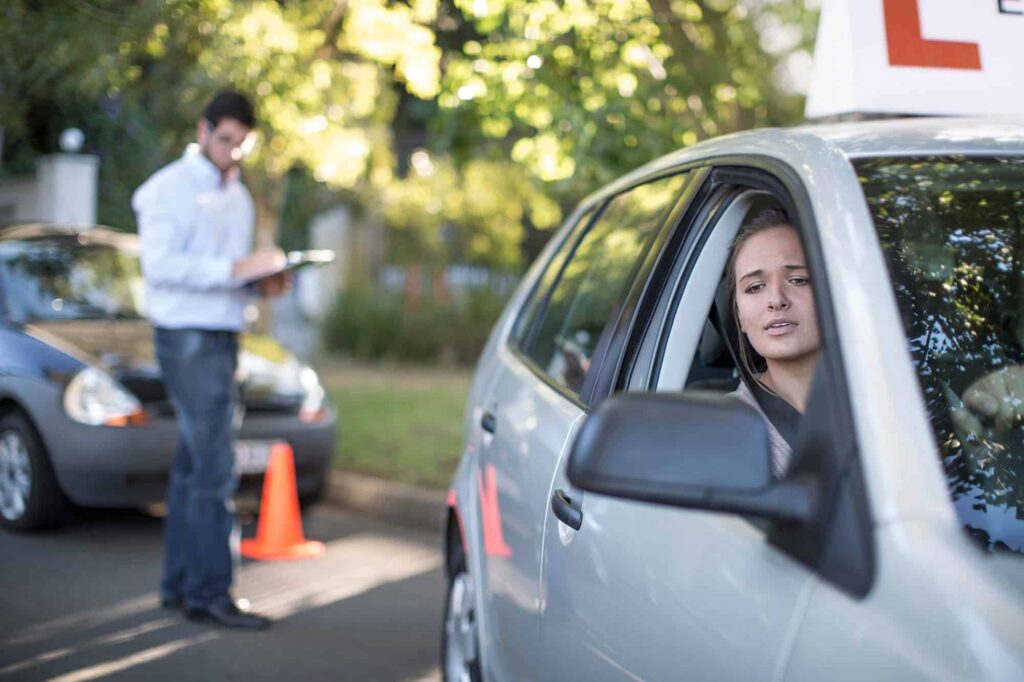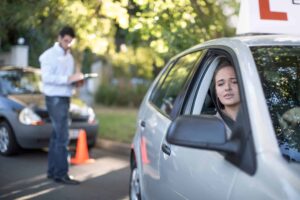Are there any quiet areas in the GTA to practice driving? Finding calm in the chaos of the GTA can feel like searching for a needle in a haystack.
With over 7 million residents and daily traffic volumes routinely peaking on major routes like the DVP and 401, new drivers often face gridlock that heightens anxiety and stalls learning. Yet practicing in quieter areas offers a powerful antidote.
When you’re not battling bumper-to-bumper traffic, you can focus on mastering core skills such as controlled lane changes, smooth stops, precise turns, and parking drills without the constant pressure of honking horns or fast-approaching vehicles.
Research shows that even modest increases in driving speed significantly raise accident risk, so beginning at lower speeds helps build both competence and confidence.
In this guide, we’ll explore:
- What makes a “quiet” practice zone
- Key criteria for selecting the ideal spot
- Recommended neighbourhood pockets across the GTA’s five regions
- Alternative venues like empty parking lots and industrial parks
- Tips for planning, safety, and local etiquette
- Tech tools to boost your practice
- How to scale up from empty streets to busier roads
Whether you’re prepping for your G2 road test or simply sharpening your skills, you’ll come away with concrete, data-backed strategies and real-world recommendations to accelerate your journey toward becoming a confident GTA driver.
Defining a “Quiet” Practice Area
What makes a street truly “quiet” for practice? It’s more than just fewer cars. It’s about safety, predictability, and space to learn without pressure.
Key Characteristics
- Low Traffic Volume
- Ideally fewer than 200 vehicles per hour, which minimizes interruptions and lets you repeat maneuvers smoothly.
- Simple Road Layouts
- Straight segments and gentle curves, with minimal intersections. This helps you build muscle memory before tackling complex junctions.
- Safe Parking Options
- Streets or lots with clearly marked curb space or designated bays, allowing you to practice start/stop drills and parking exercises without risking a ticket or blocking a driveway.
Time-of-Day and Day-of-Week Considerations
- Early mornings (7–9 AM) and late evenings (7–10 PM) often see light residential traffic.
- Weekdays mid-morning (10 AM–2 PM) can be especially calm in school neighbourhoods while classes are in session.
- Weekend mornings are usually quiet, though Sunday afternoons can see clusters of pedestrians and cyclists.
Scouting and Evaluation Tools
- Google Maps traffic layer lets you preview congestion patterns for any hour of the day.
- Municipal traffic-camera feeds allow on-the-spot checks of intersection activity.
- DriveTest route overlays Identify official road-test segments so you can avoid accidentally practicing on them until you’re ready.
Criteria for Choosing the Right Spot
Not every empty street is ideal for practice. The right spot balances low traffic with good visibility, simple layouts, and enough room to build skills safely.
Road Type and Layout
- Wide Residential Streets vs. Cul-de-sacs
- Streets at least 8 metres across offer room for multi-point turns, while cul-de-sacs let you practice U-turns and looped driving in a controlled setting.
- Avoid Multi-lane Arterials and Major Intersections
- High-speed, multi-lane roads introduce complexity that’s better tackled once basic maneuvers are solid.
Availability of Legal Parking
Look for streets without “No Parking” signs or designated permit-only zones. This ensures you can pull over safely for curb-side parking practice and stop-start drills.
Presence of Pedestrian or Cyclist Traffic
Aim for areas with only occasional non-motorized activity. A stray cyclist crossing your path can be a valuable learning moment, but constant foot traffic can overwhelm a new driver.
Proximity to Home or Driving School
Keep practice spots within a 15-minute drive when possible. This maximizes hands-on time and keeps supervising drivers or instructors fresh.
Seasonal Considerations
- School Breaks: March Break and summer holidays bring extra weekend traffic to school zones, so plan around them.
- Winter Conditions: Cleared residential crescents after a snowfall often see less through traffic; just be mindful of ice patches and reduced visibility.
Are there any quiet areas in the GTA to practice driving?
Below are neighbourhood pockets known for calmer streets. Always double-check current conditions before heading out.
Toronto (City of Toronto)
- Don Mills Residential Pockets (North York–GTA border)
- Grid layouts south of York Mills Road feature gentle curves and generous sidewalks, making them perfect for lane-discipline drills.
- Leaside Side Streets (Midtown)
- Sutherland Drive and surrounding crescents are wider than average, with few signalized intersections.
- The Beaches Residential Zones (East End)
- Two blocks north of Queen Street East, quiet grid blocks allow uninterrupted practice after morning rush hour.
Scarborough
- Highland Creek Side Streets
- Gentle inclines near Kingston Road let you rehearse uphill starts in a low-stress environment.
- West Hill Loops off Morningside Avenue
- Mini-cul-de-sacs provide clear sightlines and ample turning radius.
- Agincourt Older Subdivisions near Bellamy Road
- Mature trees offer shade; weekday afternoons see minimal local traffic.
Etobicoke
- Thistletown & Rexdale Crescents
- Narrow, looping streets experience near-zero cut-through volume, ideal for beginner turns.
- South Etobicoke Cul-de-sacs (Lakeshore Blvd West)
- Scenic vistas and light weekend foot traffic make it a pleasant place to practice, just watch for joggers on the waterfront paths.
- Scenic vistas and light weekend foot traffic make it a pleasant place to practice, just watch for joggers on the waterfront paths.
- The Kingsway Side Streets
- Residential roads adjacent to Royal York Road quiet down between 9 AM and 2 PM on school days.
North York
- Willowdale Crescents off Yonge Street
- Even pavement and broad curb lanes encourage smooth merge practice.
- Don Mills–Finch Neighbourhood near Sunnybrook Park
- Straight connecting roads and leafy turns make this area great for honing scanning techniques.
- Bayview Side Streets around Sunnybrook Park
- Dead-end crescents let you repeat backing and parallel-parking drills with minimal interruption.
East York
- Thorncliffe Park Loops
- Quiet grid blocks with marked bays; moderate pedestrian presence keeps you alert without overwhelm.
- O’Connor–Cosburn Pockets
- Straight, tree-lined streets offer consistent practice conditions almost daily.
- Leaside Townhome Rows (post-school hours)
- Narrow residential roads become exceptionally calm after 3 PM, making them ideal for precise steering and lane discipline.
Alternative Practice Venues
When residential streets aren’t available or you crave more open space, consider the following options:
Empty Commercial Parking Lots
- Big-Box Retail Lots After Hours
- Home Depot and IKEA lots clear out after 9 PM on weekdays; confirm closing times before arriving.
- Community Centre & Church Lots on Weekends
- Often empty Friday evenings and Sunday afternoons between 1 PM and 5 PM.
School and University Parking Lots
- High School Lots During Summer Break
- July and August offer broad, empty asphalt, making them ideal for high-speed lane-change drills in a controlled area.
- July and August offer broad, empty asphalt, making them ideal for high-speed lane-change drills in a controlled area.
- College Campuses on Holidays
- Christmas and March Break sees many campus lots fully vacated, though spot security checks can apply.
Industrial Parks
- Early Weekend Hours in Business-District Zones
- Large warehouse complexes lie idle Saturday mornings, giving you room to practice large-radius turns and off-peak merges.
- Pros & Cons
- Pros: Wide lanes, long straightaways; Cons: Occasional truck traffic, variable lighting.
Planning Your Practice Sessions
A quiet area means little without a plan. Structuring your sessions with clear goals, times, and routes helps you make steady progress and stay focused behind the wheel.
Mapping & Timing Visits
- Leverage Google Maps’ traffic heatmap and Waze to pick slots when corridors run clear.
- Plan repeat visits at the same time each week to gauge consistency and improvement.
Setting Clear Objectives
Focus each session on one or two maneuvers:
- Session 1: Multi-point turns and three-point U-turns
- Session 2: Parallel parking and curb-side stops
- Session 3: Lane changes and merge drills
Logging Progress
Keep a practice journal noting date, time, location, weather, maneuvers attempted, and areas for improvement. Review weekly to track skill curves and adjust targets.
Riding with a Mentor
Book a bi-weekly review ride with an instructor or experienced driver. Their real-time feedback helps correct small mistakes before they become habits.
Safety and Etiquette
Practicing in calm areas doesn’t mean ignoring safety. Following road rules, respecting residents, and staying alert are just as important as in busy traffic.
- Obey Speed Limits and local bylaws. Even in empty lots, it’s best to err on the side of caution.
- Respect Neighbours: don’t block driveways or idle in front of homes.
- Weather Precautions: look out for black ice in late fall and early spring; reduce speed in rain and low-sun glare.
- Learner Regulations:
- G1: must have a supervising driver with ≥ 4 years’ experience.
- G2: initial night-time driving restrictions and zero blood-alcohol requirement for the first six months.
Using Technology to Enhance Practice
Apps and tools can turn a simple drive into a smart learning session. From GPS route planning to real-time feedback, the right tech helps you track progress and sharpen your skills efficiently.
- Route-simulation Apps: tools like Driving Test Success simulate GTA road-test scenarios so you know what to expect.
- Dashcams: recording your sessions lets you replay and spot hesitation points or missed mirror checks.
- Real-Time Alerts: apps such as Traffic-Alert ON send push notifications about new construction or signal outages on your planned route.
Transitioning from Quiet Areas to Busier Roads
Once you’re confident in calm zones, it’s time to level up. Gradually introducing busier roads builds your ability to handle real-world traffic while still staying in control.
Graduated Exposure
- Empty crescents →
- Single-lane arterials off-peak →
- Multi-lane roads during light traffic →
- Full rush-hour conditions (only once you’re fully comfortable).
Next-Level Practice Zones
- Steeles Avenue East midday: one of Toronto’s widest thoroughfares for merging practice.
- Lake Shore Blvd West shoulder lanes outside rush: good for city-to-suburb transitions.
Real-World Variables
- Tackle local festivals or weekend street fairs to learn detour navigation.
- Drive past transit stops to practice yielding and gap selection around buses.
Conclusion
Starting your practice in quiet areas allows you to build core skills without sensory overload. By following the criteria and neighbourhood suggestions above, and by leveraging detailed planning, journaling, and tech tools, you’ll move from serene cul-de-sacs to bustling GTA arteries with ease.
Stay patient, track your growth, and always respect local communities. As your confidence grows, you’ll be more than ready to ace your G2 test and enjoy independent driving.
Share your favourite spots or unique tips below to help fellow GTA learners discover the low-stress zones that transformed your driving journey!






